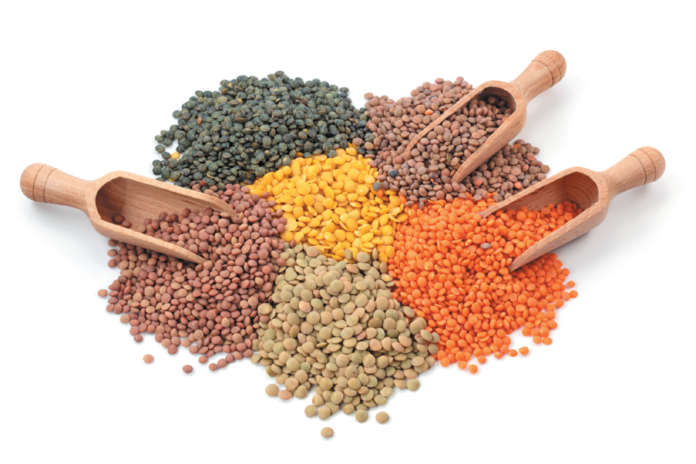Lentils may not be a staple in your pantry, but they should be! Easy to prepare, delicious, nutritious, and versatile—these tiny legumes check the boxes of an excellent food choice in a healthy dietary pattern. Despite research on the emerging health benefits of regular legume consumption, most Americans are not giving them the love they deserve. A recent study showed that fewer than five percent of consumers ate beans or lentils daily, and about one-third hadn’t eaten them in the last month. It’s time to put lentils in the limelight and explore some ways to get them into your pantry and onto your table.
Lentil Nutrition. Part of the legume family, along with soybeans, fresh peas, and peanuts, lentils are further classified as pulses, which are the dry, edible seeds from a legume plant. Other pulses include dry beans and peas.
Lentils are an excellent source of protein and fiber and are also high in potassium, folate, and polyphenols (plant compounds some researchers suggest have antioxidant potential). “Compared to other pulses, lentils provide more protein and iron—approximately nine grams of protein per half-cup serving and three grams of iron,” says Nicola McKeown, PhD, an associate professor at the Friedman School. That’s 18 percent of the daily recommended value for each nutrient. That same half-cup serving of cooked lentils packs eight grams of fiber, which is more than a quarter of the recommended 25 to 30 grams per day.
Including lentils in your diet doesn’t just make it easier to meet fiber recommendations, says McKeown, “lentils also provide both soluble and insoluble fiber, and thus can deliver a host of benefits, from lowering cholesterol to increasing fermentation and production of short chain fatty acids,” promoting gut health and delaying absorption of carbohydrates to keep blood sugar under control.
Research shows an association between the fiber in lentils and lower blood cholesterol levels as well as lower risk of colon cancer and type 2 diabetes.
In contrast to most legumes, lentils require no soaking, and they have a short cook time.
- Rinse lentils (whole or split).
- Using 3 cups liquid (water, broth) to 1 cup lentils, bring to boil on the stovetop.
- Boil whole lentils 15–20 minutes; split lentils about 10 minutes.
Season as desired. You can expect lentils to double or triple in volume.
Lentils 101. There are more varieties of lentils than many people realize. The differences between them are what make them suitable to particular types of recipes. In the U.S., green, brown, red, yellow, and orange lentils are commonly available. Dried lentils may be whole, which means their husks are intact, or split, which means the husks are removed. Whole lentils take longer to cook (about 15 to 20 minutes) and tend to retain their shape, while split lentils cook in about half that time and may break down to a sort of mash.
Whole green and brown lentils work well in broth soups, casseroles, and side dishes. Specialty varieties, such as beluga or puy, which also hold their shape when cooked, are often the star ingredient in salads and sides. Red and yellow lentils, as well as split green and brown lentils, cook more quickly and break down, which makes them ideal to puree and use as a thickener in soups, stews, and curries.
How to Use Lentils. If you’re new to cooking with or even eating lentils, McKeown suggests swapping out some or all of a less healthy starch, like white rice and potatoes, in a dish. A recent study found that, compared to consuming full servings of rice or instant potatoes, consuming a mixture of half rice and half lentils or half potato and half lentils significantly lowered blood glucose levels in healthy adults. A rice pilaf, stuffed bell pepper, or soup enhanced with lentils adds a new twist to the recipe, gives a nutrient boost, and slows carb absorption, which may keep you feeling full longer. Lentils are also a common meat replacement, widely utilized in vegetarian diets. Substitute some or all of any ground meat or ground poultry in recipes like tacos or pasta dishes.
Lentils are available dried, canned, and pre-cooked, as well as in mixes, ready-made soups, and frozen meals. Products made with lentils—pasta, crackers, dips, veggie burgers—are popping up in supermarkets. Check ingredient labels to make certain these products contain the entire lentil and not just refined lentil flour—and watch for added salt (especially in soups), sugar, and other ingredients you want to avoid.
Try these tips for boosting intake of delicious, nutritious, versatile lentils:
- Know Your Varieties. Choose whole lentils when you want them to stay firm and keep their shape and split varieties for quicker cooking and a soft or even creamy consistency.
- Think About Color. Choose colorful lentils for mixed dishes to add variety and interest.
- Swap it Out. Replace some or all of less healthy starches or meats in a dish with lentils.
- Toss ‘em In. Stir lentils into soups, chilis, grains, and salads for added fiber and texture.
- Be Quick. Canned, pre-cooked, and ready-made lentil products can be quick and convenient ways to serve up this legume.
























